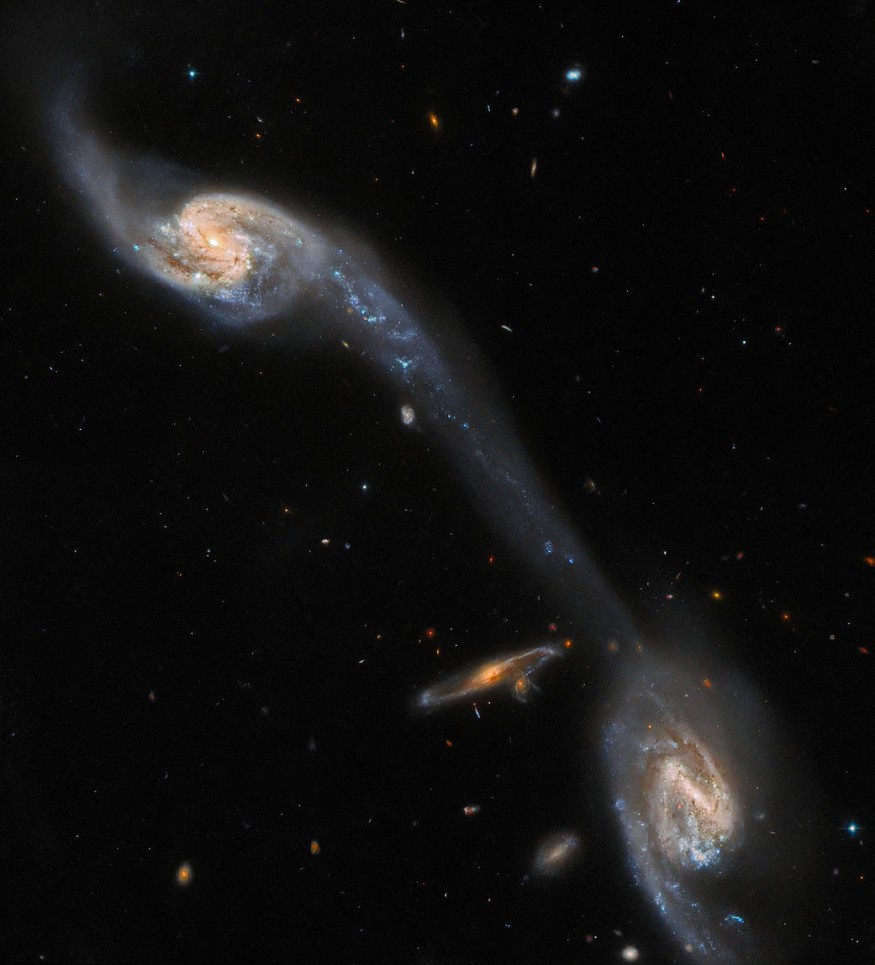The universe is so huge that its component flows in fascinating ways, such as interacting galaxies. NASA/ESA Hubble Space Telescope recently took an image of the galactic triplet Arp 248 about 200 million light-years from Earth in the constellation Virgo.
The image shows two of the three galaxies of Arp 248 flanking another smaller unrelated galaxy in the background. The two galaxies are connected by a stream of dust, gas, and stars formed as galaxies tug on each other gravitationally.

Hubble Captures Wild's Triplet
According to a press release, the Hubble Space Telescope image shows two galaxies of the galactic triplet Arp 248, also known as Wild's Triplet. This galactic marvel sits 200 million light-years from Earth and is known for its luminous bridge of stars between them, indicating an underway merging process.
The galactic triplet shows a perfect example of a tidal bridge, wherein galaxies begin to interact gravitationally as they approach each other. The galaxies might also slam into one another in the future, albeit like a slow dance, as they get close to each other before moving away again.
Eventually, scientists predict that the galaxies will become one in the future. However, doing so means they will distort each other and tug at smaller spiral arms so much that the tidal force could stretch them. The photo shows a splendid example of how the galaxies are connected.
READ ALSO : James Webb Space Telescope May Have Found the Oldest Galaxy Ever That Existed 13.5 Billion Years Ago
Weird and Wonderful Galaxies
Universe Today reports that the image of the galaxies is from an observing project that examines two collections of unusual galaxies, of which Halton Arp is included. He was an American astronomer who created the Atlas of Peculiar Galaxies in 1966, which contains 338 galaxies chosen for their unusual shape and is intended to highlight a variety of bizarre structures that galaxies could take.
In 1987, Arp and his fellow astronomer Barry Madore published the second collection of unusual galaxies in the observing project. It was called A Catalogue of Southern Peculiar Galaxies and Associations. Both collections contain information on various spectacularly peculiar galaxies, such as Arp 248, the three-armed spiral galaxies, shell-like galaxies, and many others.
In the case of Hubble, NASA/ESA scientists use its Advanced Camera for Surveys to scour this assortment of weird but wonderful galaxies to search for promising candidates for future observations with the James Webb Space Telescope and the Atacama Large Millimeter/submillimeter Array (ALMA).
IFL Science also reported that previous observations had yielded smaller galaxies than the Milky Way, like the Gaia-Enceladus Sausage galaxy. Others are also in a slower merging path, like the Large and Small Magellanic Clouds, both visible to the naked eye from the Southern hemisphere.
They move around the Milky Way and interact with the galaxy. Scientists say that the two Magellanic clouds are connected to the galaxy via the Magellanic stream and a bridge between the two clouds composed of few stars, a lot of gas, and a weak magnetic field.
Scientists hope that the wealth of astronomical objects to study in the night sky will guide future galactic observations that are a valuable investment of observing time.
RELATED ARTICLE: NASA Hubble Space Telescope Finds Spiral Galaxy Showing Its Spiral Arms
Check out more news and information on Space in Science Times.
© 2025 ScienceTimes.com All rights reserved. Do not reproduce without permission. The window to the world of Science Times.












